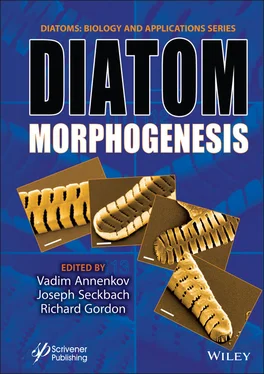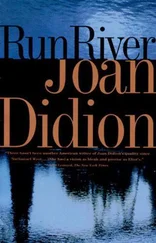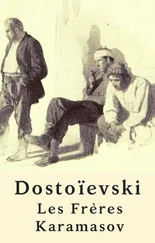Diatom Morphogenesis
Здесь есть возможность читать онлайн «Diatom Morphogenesis» — ознакомительный отрывок электронной книги совершенно бесплатно, а после прочтения отрывка купить полную версию. В некоторых случаях можно слушать аудио, скачать через торрент в формате fb2 и присутствует краткое содержание. Жанр: unrecognised, на английском языке. Описание произведения, (предисловие) а так же отзывы посетителей доступны на портале библиотеки ЛибКат.
- Название:Diatom Morphogenesis
- Автор:
- Жанр:
- Год:неизвестен
- ISBN:нет данных
- Рейтинг книги:5 / 5. Голосов: 1
-
Избранное:Добавить в избранное
- Отзывы:
-
Ваша оценка:
- 100
- 1
- 2
- 3
- 4
- 5
Diatom Morphogenesis: краткое содержание, описание и аннотация
Предлагаем к чтению аннотацию, описание, краткое содержание или предисловие (зависит от того, что написал сам автор книги «Diatom Morphogenesis»). Если вы не нашли необходимую информацию о книге — напишите в комментариях, мы постараемся отыскать её.
A unique book presenting the range of silica structures formed by diatoms, theories and hypotheses of how they are made, and applications to nanotechnology by use or imitation of diatom morphogenesis.
Audience
Diatom Morphogenesis — читать онлайн ознакомительный отрывок
Ниже представлен текст книги, разбитый по страницам. Система сохранения места последней прочитанной страницы, позволяет с удобством читать онлайн бесплатно книгу «Diatom Morphogenesis», без необходимости каждый раз заново искать на чём Вы остановились. Поставьте закладку, и сможете в любой момент перейти на страницу, на которой закончили чтение.
Интервал:
Закладка:
Table of Contents
1 Cover
2 Title page
3 Copyright
4 Preface
5 Part 1 GENERAL ISSUES 1 Introduction for a Tutorial on Diatom Morphology 1.1 Diatoms in Brief 1.2 Tools to Explore Diatom Frustule Morphology 1.3 Diatom Frustule 3D Reconstruction 1.4 Conclusion Acknowledgements References 2 The Uncanny Symmetry of Some Diatoms and Not of Others: A Multi-Scale Morphological Characteristic and a Puzzle for Morphogenesis 2.1 Introduction 2.2 Methods 2.3 Results 2.4 Discussion References 3 On the Size Sequence of Diatoms in Clonal Chains 3.1 Introduction 3.2 Mathematical Analysis of the Size Sequence 3.3 Observations 3.4 Conclusions Acknowledgements Appendix 3A L-System for the Generation of the Sequence of Differences in Size Indices of Adjacent Diatoms Appendix 3B Probability Consideration for Loss of Synchronicity References 4 Valve Morphogenesis in Amphitetras antediluviana Ehrenberg 4.1 Introduction 4.2 Material and Methods 4.3 Observations 4.4 Conclusion Acknowledgments References Glossary
6 Part 2 SIMULATION 5 Geometric Models of Concentric and Spiral Areola Patterns of Centric Diatoms 5.1 Introduction 5.2 Set of Common Rules Used in the Models 5.3 Concentric Pattern of Areolae 5.4 Spiral Patterns of Areolae 5.5 Conversion of an Areolae-Based Model Into a Frame-Based Model 5.6 Conclusion Acknowledgements References 6 Diatom Pore Arrays’ Periodicities and Symmetries in the Euclidean Plane: Nature Between Perfection and Imperfection 6.1 Introduction 6.2 Materials and Methods 6.3 Results and Discussion 6.4 Conclusion Acknowledgment Glossary References 7 Quantified Ensemble 3D Surface Features Modeled as a Window on Centric Diatom Valve Morphogenesis 7.1 Introduction 7.2 Methods 7.3 Results 7.4 Discussion 7.5 Conclusions Acknowledgment References 8 Buckling: A Geometric and Biophysical Multiscale Feature of Centric Diatom Valve Morphogenesis 8.1 Introduction 8.2 Purpose of Study 8.3 Background: Multiscale Diatom Morphogenesis 8.4 Biophysics of Diatom Valve Formation and Buckling 8.5 Geometrical and Biophysical Aspects of Buckling and Valve Formation 8.6 Methods 8.7 Results 8.8 Conclusion References 9 Are Mantle Profiles of Circular Centric Diatoms a Measure of Buckling Forces During Valve Morphogenesis? 9.1 Introduction 9.2 Methods 9.3 Results 9.4 Discussion 9.5 Conclusion Acknowledgement References
7 Part 3 PHYSIOLOGY, BIOCHEMISTRY AND APPLICATIONS 10 The Effect of the Silica Cell Wall on Diatom Transport and Metabolism Publications by and about Mark Hildebrand 11 Diatom Plasticity: Trends, Issues, and Applications on Modern and Classical Taxonomy, Eco-Evolutionary Dynamics, and Climate Change 11.1 Introduction 11.2 Model Species: Phaeodactylum tricornutum 11.3 Transformation Mechanisms of P. tricornutum 11.4 Future Advances in the Phenotypic Plasticity on P. tricornutum 11.5 Conclusion References 12 Frustule Photonics and Light Harvesting Strategies in Diatoms 12.1 Introduction 12.2 Light Spectral Characteristics and Signaling 12.3 Photosynthesis and Photo-Protection in Diatoms 12.4 Frustule Photonics Related to Diatom Photobiology 12.5 Frustule Photonics in Light of Niche Differentiation 12.6 Conclusion References 13 Steps of Silicic Acid Transformation to Siliceous Frustules: Main Hypotheses and Discoveries 13.1 Introduction 13.2 Penetration of the Boundary Layer: The Diatom as an Antenna for Silica 13.3 Getting Past the Cloud of Extracellular Material 13.4 Adsorption of Silica Onto the Outer Organic Coat of the Diatom 13.5 Getting Past the Silica Frustule or Through Its Pores 13.6 Getting Past the Inner Organic Coat, the Diatotepum 13.7 Transport of Silica Across the Cell Membrane 13.8 Cytoplasm Storage and Trafficking of Silica to the Places of Synthesis of the Frustule Parts 13.9 Transport and Patterning of Silica Across the Silicalemma 13.10 Precipitation and Morphogenesis of the Nascent Valve Within the Silicalemma 13.11 Thickening of the Valve Within the Silicalemma 13.12 Exteriorization of the Valve 13.13 Future Work Needed 13.14 Conclusion References 14 The Effects of Cytoskeletal Inhibitors on Diatom Valve Morphogenesis 14.1 Introduction 14.2 Cytoskeleton and Its Role in Cell Morphogenesis 14.3 Abnormalities of Diatom Valve Morphogenesis Induced by Cytoskeleton Inhibitors 14.4 Conclusion Acknowledgment References 15 Modeling Silicon Pools in Diatoms Using the Chemistry Toolbox 15.1 Diatoms 15.2 “Silicon Pools” Biology 15.3 Silica Particle Formation From Silicic Acid 15.4 Stabilization of “Soluble” Silica Species (Monosilicic and Disilicic Acids) 15.5 Chemical Mechanisms 15.6 Conclusions/Perspectives Acknowledgments References 16 The Mesopores of Raphid Pennate Diatoms: Toward Natural Controllable Anisotropic Mesoporous Silica Microparticles 16.1 Introduction 16.2 Morphology and Very Fine Ultrastructure of Diatom Frustules 16.3 Synthetic Mesoporous Silica 16.4 The Potential of Raphid Pennates’ Mesoporous Bio-Silica, Similarities, and Dissimilarities Compared With Synthetic MSM/Ns 16.5 Our Ability to Control the Diatom Frustule’s Ultrastructure 16.6 Conclusion Acknowledgment References Glossary
8 Index
9 Also of Interest
10 End User License Agreement
Guide
1 Cover
2 Table of Contents
3 Title page
4 Copyright
5 Preface
6 Begin Reading
7 Index
8 End User License Agreement
List of Illustrations
1 Chapter 1Figure 1.1 Living diatoms as observed under LM, brightfield. (a) Two living cel...Figure 1.2 Live centric (a, b) and pennate (c–h) diatoms. (a, b) Pleurosira laev...Figure 1.3 Specific diatom morphology gleaned from images with whole and partial...Figure 1.4 Cleaned diatoms in valve (g, h–j, m–r, u, v) and girdle views (a–f, k...Figure 1.5 (a) SEM of a single cleaned partially open frustule, two overlapping ...Figure 1.6 A cross-section at the center of Coscinodiscus sp. cell collected and...
2 Chapter 2Figure 2.1 A drawing composed by JLP that is reminiscent of one of Mezzanotte’s...Figure 2.2 Shape perception of Arachnoidiscus ehrenbergii from image ProvBay5_1...Figure 2.3 Diatom valve face symmetries. (a) Arachnoidiscus ehrenbergii-rotatio...Figure 2.4 Double translational symmetry at two scales exhibited in a Paralia s...Figure 2.5 Three stages of valve formation (as defined in [2.125]) in Biddulphi...Figure 2.6 ProvBay5_12lx450, Arachnoidiscus ehrenbergii. (a) Original scanning ...Figure 2.7 Tilt-corrected final entropy vs. number of rotations for all images,...Figure 2.8 Typical entropy vs. symmetry plot. The example is image ProvBay5_12l...Figure 2.9 Number of rotations vs. tilt-corrected final entropies for Cyclotell...Figure 2.10 Histogram and overlain probability density function for all tilt-co...Figure 2.11 Histogram and overlain cumulative density function for all tilt-cor...Figure 2.12 For all images, average symmetry per taxon ranging from Triceratium...Figure 2.13 Average taxon symmetry for all external centric diatom valves rangi...Figure 2.14 Vertical valve formation comparison: average external and forming v...Figure 2.15 Symmetry values for Asteromphalus, Arachnoidiscus, and Aulacodiscus ...Figure 2.16 Cyclotella meneghiniana symmetry for normal and abnormal valves.Figure 2.17 Cyclotella meneghiniana symmetry values for normal forming and exte...Figure 2.18 Asterolampra marylandica (SanDBay02_03dx1100) as a sequence of 24 c...Figure 2.19 Plots of symmetry vs. 24-valve formation simulation steps from annu...Figure 2.20 Valve formation steps for eight taxa as a probability density funct...Figure 2.21 Valve formation steps for eight taxa as a cumulative density functi...Figure 2.22 Valve formation steps for eight taxa as a skew-right normal prior p...Figure 2.23 Valve formation simulation comparison of symmetry and chaotic insta...Figure 2.24 Valve formation simulation comparison of symmetry and random instab...Figure 2.25 Average sequence of 24 simulated valve formation steps of symmetry ...
Читать дальшеИнтервал:
Закладка:
Похожие книги на «Diatom Morphogenesis»
Представляем Вашему вниманию похожие книги на «Diatom Morphogenesis» списком для выбора. Мы отобрали схожую по названию и смыслу литературу в надежде предоставить читателям больше вариантов отыскать новые, интересные, ещё непрочитанные произведения.
Обсуждение, отзывы о книге «Diatom Morphogenesis» и просто собственные мнения читателей. Оставьте ваши комментарии, напишите, что Вы думаете о произведении, его смысле или главных героях. Укажите что конкретно понравилось, а что нет, и почему Вы так считаете.












